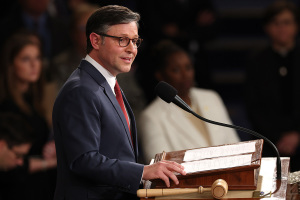Christians Respond to Obama's New HIV/AIDS Strategy
WASHINGTON – President Obama rolled out on Tuesday a new HIV/AIDS strategy to tackle the high infection rate and the stigma still associated with the disease on home ground.
Of the 33 million people living with HIV around the world, more than 1.1 million of them are in the United States. And every year approximately 56,000 people become infected. Yet the public's sense of urgency in combating the epidemic has stemmed, the White House National HIV/AIDS Strategy states.
While HIV transmission rates are not as high as they once were in the U.S., "every new case is one case too many," Obama said at a reception at the White House Tuesday.
"[W]e have learned what we can do to stop the spread of the disease. We've learned what we can do to extend the lives of people living with it," he noted. "The question is not whether we know what to do, but whether we will do it?"
The comprehensive plan has three primary goals: reduce the number of new HIV infections, increase access to care and optimize health outcomes for people living with the disease, and reduce HIV-related health disparities (i.e. stigma and discrimination).
In response to the new strategy, Craig Jaggers, U.S. senior policy adviser for global health at World Vision, told The Christian Post: "As an international Christian relief, development and advocacy organization, World Vision focuses its attention internationally, where a vast majority of AIDS deaths and HIV infections occur. However, it is important that our government and domestic organizations that provide prevention, treatment and care to Americans continue to hone and improve strategies to defeat this disease."
Obama had vowed during his presidential campaign to focus on the HIV/AIDS pandemic at the domestic level. His commitment follows former President George W. Bush's lauded contribution in combating the disease globally. The Bush administration created the President's Emergency Plan for AIDS Relief (PEPFAR) which funneled $18.8 billion toward fighting HIV/AIDS, mainly in Africa.
"PEPFAR has been a very effective internationally, in part due to adaptability of the program and mechanisms that enabled groups like World Vision to report what is working and is not working in AIDS-affected communities," Jaggers commented. "Irrespective of any specific provisions in the current strategy, it is encouraging that the Administration appears to be utilizing this lesson learned from PEPFAR."
In developing the national strategy, the Obama administration took a bottom up approach that included 14 community discussions involving over 4,200 people as well as receiving hundreds of recommendations on the White House website.
Obama stressed that the ambitious vision to make the U.S. a place where new HIV infections are rare and where every person will have unfettered access to care cannot be achieved by the government alone. It will require the commitment of all parts of society.
Elizabeth Styffe, who founded the HIV/AIDS initiative with Kay Warren at Southern California's Saddleback Church, told The Christian Post that more churches are coming on board to extend care and love to HIV infected persons. More Christians are also willing to adopt HIV-positive children.
In fact, Styffe believes that they have come to a point where they don't have to lean on the government.
"It's exciting to think about being a Christian and being in a church in an era where ... we don't have to count on the government," she commented. "Even when the government does big things and allocates money, when it comes to implementing treatment, implementing care, distributing medication, helping people learn about prevention, and [providing] access to care, it all can come through the local church."
"The hope is the church," she said confidently, noting that there are 2 billion persons in the world who call themselves Christian.
Nevertheless, Styffe welcomed Obama's new strategy.
"Whenever the world or our local communities in the U.S. think about the people who are in our own neighborhoods who are living with HIV, we're happy," she said. Moreover, Christians should be glad "when our government recognizes where much is given, much is required."
HIV/AIDS is a very unique illness, Styffe noted. No other disease carries the stigma that it does.
"There are very few diseases still in 2010 where you have to whisper," she lamented.
Challenging Christians to remove the stigma, she said, "Churches can be the ones where you can say it is not a sin to be sick. Jesus never said how did you get sick. He said how can I help.
"There are people in their own community waiting to be loved."
Some statistics that were outlined in the National HIV/AIDS Strategy paint a sober picture. Approximately one in five people living with HIV are unaware of their status, placing them at greater risk for spreading the virus to others; roughly three-fourths of HIV/AIDS cases in the United States are among men, the majority of whom are gay and bisexual men; one quarter of new HIV infections occur among adolescents and young adults (ages 13 to 29); and racial and ethnic minorities are disproportionately represented in the HIV epidemic and die sooner than Whites.





























